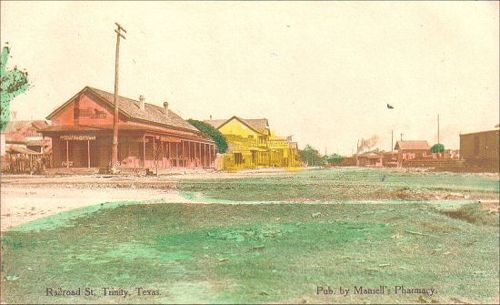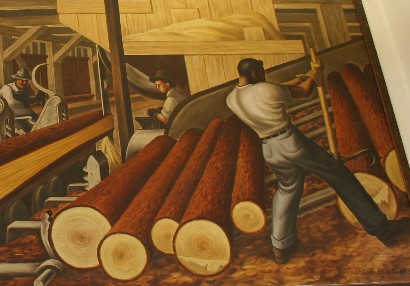|
TRINITY, TEXAS
Former Trinity
County Seat
Trinity
County, East Texas
30° 56' 44" N, 95° 22' 32" W (30.945556, -95.375556)
State Hwy 19 and Hwy 94 with
FMs 230, 356, and 1617
2 Miles NE of the Trinity River
21 Miles NE of Huntsville
20 Miles SW of Groveton the county
seat
ZIP code 75862
Area code 936
Population: 2,756 Est. (2019)
2,697 (2010) 2,721 (2000) 2,648 (1990)
Trinity, Texas Area Hotels › Huntsville
Hotels |
"Trinity,
Texas, July 2, 1920
Photo by Congdon, For Taylor & Young"
Click on image to enlarge
Old Photo
courtesy Dan
Whatley Collection |
History in
a Pecan Shell
An early community known as Kayser’s Prairie, occupied the
land prior to the 1870s. The town we now know as Trinity became a
station on the Houston and Great Northern Railroad in 1872 although
it was first Trinity Station and then Trinity City before
dropping the extra words.
The railroad increased the population dramatically when it bypassed
the county seat (Sumpter, Texas).
Trinity became the county seat in May of 1873 although that status
was short-lived.
In 1874 Pennington became the county
seat, even though Trinity was the county’s railroad center and its
most populated community. The population reached 900 in the mid 1880s
which swelled to 1,200 for the 1890 census.
A fire destroyed 12 houses in 1892 but that doesn’t explain the drop
in population (just 500 by 1896).
By 1904 it had 850 residents and the town was electrified in 1906.
A second fire in 1909 destroyed the town’s business district and a
third fire in 1915 (when the population had reached 1,800) caused
further damage, but the town rebuilt on each occasion. The population
grew slowly, reaching nearly 2,650 in 1990.
Trinity was (after cotton growing
declined in the 1920s) a timber center and once had 30 sawmills in
operation at its peak.
The Texas Department of Corrections has several prisons in the area.
|
 |
Trinity, Texas
Historic Attractions
|
| Attractions &
Historical Markers |
|
Trinity's 1942
Post Office Mural
"Lumber Manufacturing"
by Jerry Bywaters
Photo
courtesy Marilyn Tomalavage, 2011
|
Historical Marker:
Gray at Robb streets, Trinity, Texas
Texas Long
Leaf Lumber Company
In 1907, Thompson
Brothers Lumber Company built a mill and 37-acre pond at Trinity.
Texas Long Leaf Lumber Company, which started at Willard in 1912,
bought Thompson Brothers’ Trinity Mill in 1922.
Under management of Paul Sanderson for 22 years, the company was
one of the nation’s most successful manufacturers of yellow pine
and southern hardwoods. Working with forest landowners in Texas,
Sanderson promoted selected cutting, reforestation, fire protection
and removal of defective trees. By 1937 the mill was producing 3.5
million board feet monthly. The commercial species of lumber cut
were long leaf, short leaf, and loblolly pine, oak, gum, ash, magnolia,
and various other woods. The main office of Texas Long Leaf Lumber
Company was the 205-acre mill site in Trinity, with additional sales
offices in Houston and
St. Louis.
The company was one of Trinity’s largest employers, with as many
as 450 employees. During World
War II, production reached 140,000 board feet daily, resulting
in lumber flown to Europe and Africa and the awarding of the Army-Navy
“E” Award in a march 17, 1944, ceremony in Trinity. Sanderson turned
to a widespread public campaign for postwar planning and perpetuation
of the timber industry in Texas with emphasis on timber as a renewable
natural resource. At the time of his untimely death in October 1944,
Sanderson held many civic and lumber industry offices, including
President of the Southern Pine Association, President of the Texas
Forest Association and Chairman of the Texas Prison Board. In 1953,
Texas Long Leaf timber interests totaled 252,230 acres in six East
Texas counties.
The closing
of the mill in 1955 had a devastating impact on the local economy
and ended a long chapter in the history of the community.
(2015)
|
 |
Trinity's 1942
Post Office Mural
"Lumber Manufacturing"
Photo courtesy Marilyn Tomalavage, 2011
More Texas
Post Office Murals |
Historical Marker:
100 San Jacinto,
Trinity, Texas
Old Red Schoolhouse
Trinity’s first
schoolhouse was a one-room log structure built in 1872 near Cedar
Grove Cemetery. A two-story frame schoolhouse that stood on this site
from 1897 to 1911 was moved several blocks northwest to serve African
American students. Under Supt. J. Woolam Bright, construction of a
new brick building began here in 1911, and after many delays it opened
by 1915. The prairie style, T-plan building housed all grade levels
until completion of an adjacent high school in 1928. “Old Red” served
as a schoolhouse for 80 years. When it was slated for demolition in
the 1990s, concerned citizens and former students worked with the
school district to preserve the historic building for continued use.
Recorded Texas Historic Landmark
2004
[See Restoring
Two Old Reds
by Bob Bowman (All Things Historical] |
Historical Marker:
980 South Robb, Trinity, Texas
Trinity Chapel
A.M.E. Church
The Trinity Chapel
African Methodist Episcopal Church traces its beginnings to 1882 when
it was established as a mission church. The Reverend W.M. Apling was
appointed as the first pastor. Land for a church was donated in 1887
by the New York and Texas Land Company, Ltd. A small one-room building
was erected by 1890. To house its growing numbers, the members redesigned
the sanctuary. Changes included relocating the entrance, adding a
bell tower, and attaching a wing to the north and south sides. The
pews were hand-hewn wooden benches, supported by backs decorated with
nine-inch spindles.
Several prominent area citizens have been members of this church.
The congregation promotes programs such as Sunday school and vacation
Bible school, and supports civic responsibility through local scholarships
and financial patronage of Paul Quinn College in Dallas,
and the Trinity Community Cemetery. The Church also sponsors a clothing
bank, promotes an African American parade and contributes to other
social outreach programs. The Trinity Chapel A.M.E. Church continues
to serve the Trinity area as it has for more than a century.
(1996) |
Historical Marker:
131 N. Elm St., (Elm and Caroline) Trinity, Texas
First United Methodist Church of Trinity
This
congregation was organized in 1872, the same year the City of Trinity
was founded. The Rev. John Woolam is credited with the establishment
of the church and also served as its first itinerate minister. Woolam
held services in Trinity one Sunday each month. his preaching circuit
at that time consisted on 12 to 15 stations, including Trinity, Nevilles
Prairie, Blackland, and Lovelady.
Early worship services were held in the Barnes-Lister store in Trinity.
In 1873 a one-room log schoolhouse was constructed, and it served
for a time as a community church building as well. The Methodist congregation
built the first sanctuary during the early 1880s at the corner of
what is now Robb and Madision. The one-room building soon became too
small for the growing fellowship, and additions were made in 1902
and in 1913. The current sanctuary was completed in 1928.
Throughout its history, Trinity United Methodist Church has provided
significant service and leadership to the community. With its emphasis
on christian education and missionary programs, the congregation continues
to uphold the ideals and traditions of its founders.
(1984) |
Historical Marker:
200 Robb St., Trinity, Texas
Dorcas Wills
Memorial Baptist Church
Originally known as the Trinity Baptist Church in Christ, this
congregation was formally organized on January 23, 1876, by the Rev.
D.S. Snodgrass. Charter members included J.R. and Rachel Shaw, Mrs.
S.J. Knox, O.G. Shaw, Dr. and Mrs. J.M. Arnold, and Catherine Turner.
During Snodgrass' pastorate, which lasted until December 1877, a Union
Sunday school was organized and a sanctuary was built on land donated
by the International & Great Northern Railroad. Despite early setbacks,
such as a 1909 fire that destroyed the church building, the congregation
grew in numbers and provided significant service and leadership to
the community. The current name was adopted in 1934 upon the completion
of anew sanctuary in memory of Dorcas Sheffield Wills. Over the years,
several members of the congregation have been licensed to preach.
The Calvary Baptist Church of Trinity was formed by a group from this
fellowship.
An important part of the religious heritage of Trinity, Dorcas Wills
Memorial Baptist Church continues to uphold the ideals and traditions
of its nineteenth-century founders.
(1985) |
Historical Marker:
2005 Pinecrest Road, Trinity, Texas
John Henley
Hill House
Sitting proudly on a hill surrounded by giant southern magnolia, oak,
cedar and crepe myrtle trees, the John Henley Hill house is situated
on one of the earliest plantation sites located within the Elisha
Roberts Survey. John Henley Hill was born on November 30, 1839, in
Richmond, Indiana. Following the death of his first wife and the mother
of his two children, Phoebe E. Branson, in 1870, John married her
sister, Susanna Branson, in 1871. in 1876, John and Susanna met Col.
George W. Grant while participating in a knitting machine demonstration
at the Centennial International Exposition. He encouraged them to
relocate to Grant’s Colony in Walker
County, Texas. After one year of managing the settlement, the
Hill family moved to Trinity
County. It is unknown where the Hills lived when they first arrived
but in 1880, John Hill purchased 200 acres from S.T. Robb and began
construction on this house for his family.
Built from 1880 to 1882, the two-story hill house reflects elements
of carpenter gothic architectural style, typical of rural architecture
of the period. Features include double hung windows, narrow boxcar
siding, curved arches and carved decorative sawn brackets. Multiple
porches and entries to the house provide outdoor space and cover from
the elements. White limestone fireplaces accent the first floor along
with arched entries and natural wood elements. The John Henley Hill
house stands as a representation of early Trinity
County history and rural architecture.
Recorded Texas Historic Landmark
2016 |
Historical Marker:
W. Main St., (FM 230), Trinity, Texas
Cedar Grove
Cemetery
The first documented
burial in the cemetery, that of Phebe A. Martin, took place in 1875,
three years after the town of Trinity was laid out on the George W.
Wilson survey. Nearly 100 graves, many of them from an 1897-98 diphtheria
epidemic, date to the 19th century. In 1914, a cemetery association
was chartered to manage and maintain the public burial ground. Among
those buried here are founders of Trinity, professional and business
leaders, and local citizens who served in the United States armed
forces.
Texas Sesquicentennial 1836-1986 |
| Texas
Escapes, in its purpose to preserve historic, endangered and vanishing
Texas, asks that anyone wishing to share their local history, stories,
landmarks and vintage/historic photos, please contact
us. |
|
|
